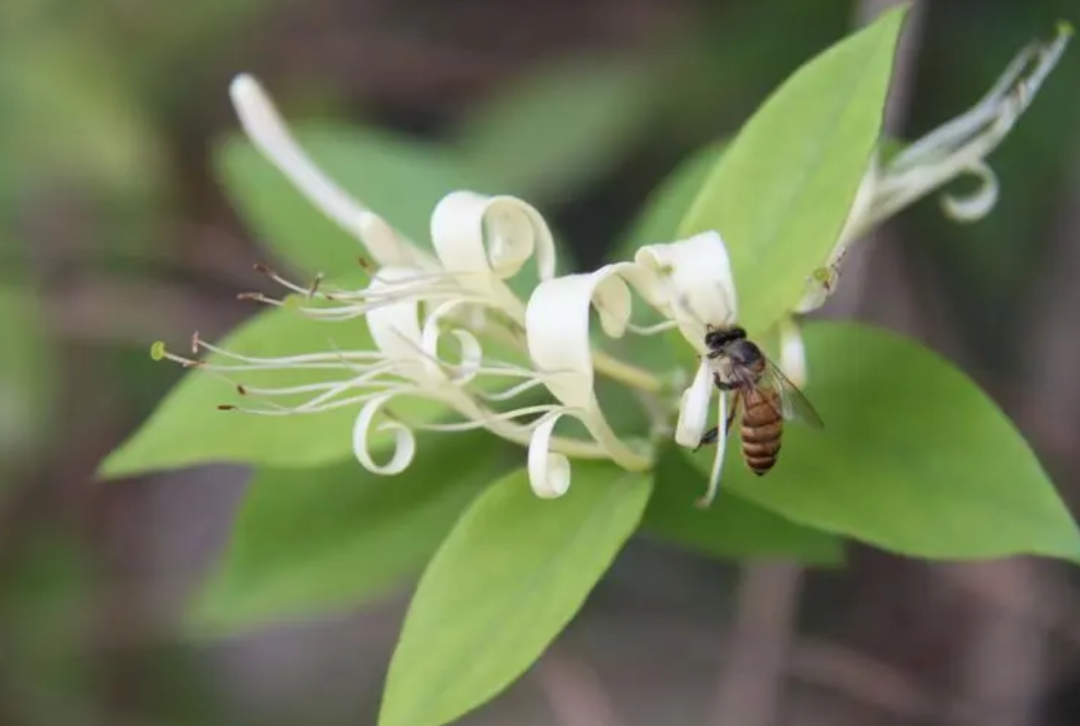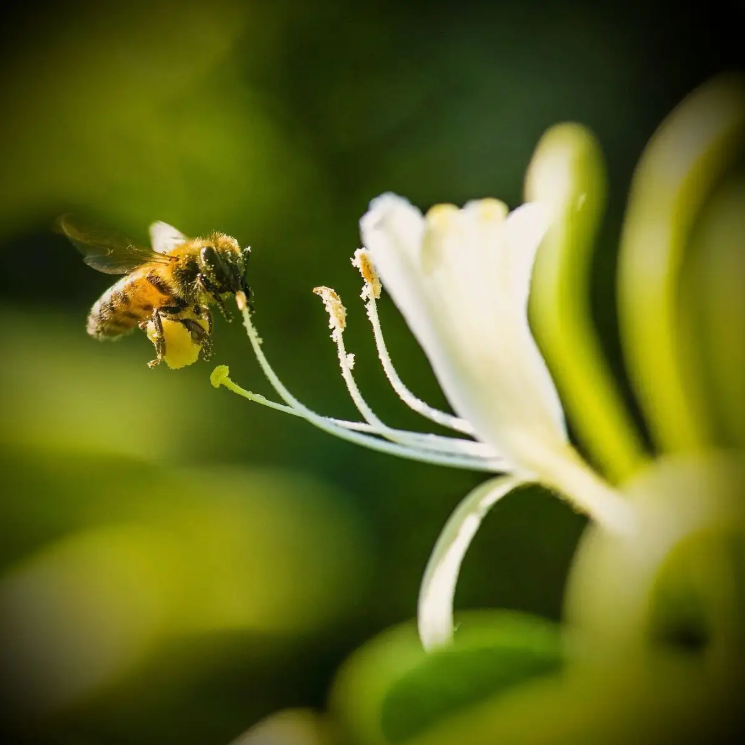
Honeysuckle (Jin Yin Hua) has excellent medicinal value, health benefits, and ornamental qualities, and is widely cultivated in China. According to incomplete statistics, the planting area of honeysuckle in China exceeds 47,000 hectares. In concentrated planting areas, it can produce commercial honey, and under industrial scale conditions, honeysuckle can become a major honey source plant. In addition, it is cultivated in many regions of China as an ornamental plant, although not on a large scale, it plays an important role in the survival of bees.Honeysuckle, a perennial climbing semi-evergreen shrub, is also known as Lonicera japonica Thumb, belonging to the Caprifoliaceae family. 1. Morphological Characteristics The stems of honeysuckle are hollow, with young branches being reddish-brown and densely covered with short hairs. The leaves are opposite, papery, entire, and covered with short soft hairs, elongated oval to ovate-lanceolate, occasionally round-ovate or inversely ovate, with a heart-shaped or round base, and a pointed or gradually pointed apex. The upper surface is dark green, while the underside is gray-green, typically measuring 3-7 cm in length and 1.5-4 cm in width, with a rounded or nearly heart-shaped base; the petiole is usually 0.4-0.8 cm long and densely covered with short soft hairs. The inflorescence is usually solitary in the axils of the upper leaves, equal to or slightly shorter than the petiole; the bracts are leaf-like, measuring 0.7-1.5 cm long; the calyx tube is about 2 mm long, with calyx lobes that are ovate-triangular or long-triangular and pointed at the apex; the corolla is slender, tubular at the base, and lip-shaped at the top, initially white, sometimes slightly reddish on the sunny side, later turning yellow, measuring 3-5 cm long, with the lower flower tube slightly longer than the upper lip petals, the upper lip lobes being blunt at the apex, and the lower lip being strap-like and reflexed, emitting a fragrance; the stamens and style are both exserted from the corolla; there are 5 stamens, slightly shorter than the style. The fruit is a round berry, 6-7 mm in diameter, glossy and blue-black when ripe; the flowering period is from March to July (often blooming in autumn), and the fruit ripens mainly in October to November. 2. Habitat Distribution Honeysuckle is highly adaptable, thriving in sunny and shady conditions, cold-resistant, drought-tolerant, and tolerant of both wet and dry soils, naturally growing in valleys, forest edges, roadside thickets, and slopes at altitudes of 1,700 to 2,000 meters. Due to its wide adaptability, honeysuckle is cultivated in most parts of China, except for a few regions. The main production areas for honeysuckle cultivation in China are concentrated in Shandong, Hebei, Henan, Shaanxi, Hubei, Jiangxi, Guangdong, Sichuan, and Chongqing. 3. Flowering and Nectar Flow Patterns In most regions of China, the peak flowering period is from April to June, with a large number of flowers and a long flowering period. In the south, flowers bloom continuously from April to November, with a long nectar flow period. During the flowering period, bees are actively foraging, especially when the temperature exceeds 22°C.

4. Nectar Yield and Quality Honeysuckle is a widely cultivated honey source plant, providing both pollen and nectar, with abundant nectar flow. Its fragrant flowers attract bees significantly, and even in light rain, bees can still be seen foraging. In areas where honeysuckle is cultivated in China, the quantity is considerable, and the distribution is broad, with rich nectar flow, benefiting bee colony reproduction, spleen tonification, and queen rearing. In recent years, honeysuckle cultivation has developed, and honeysuckle honey has become a commercial product. It is reported that a strong Western honey bee colony can yield over 20 kg of honey during peak flowering periods. The characteristics of honeysuckle honey include: yellow, thick, aromatic, prone to crystallization, with relatively coarse crystals. 5. Medicinal Value of Honeysuckle The medicinal parts of honeysuckle are the flower buds or newly opened flowers (Jin Yin Hua) and the stems (Jin Yin Hua Teng). Honeysuckle is sweet and cold in nature. The flowers have the effects of clearing heat and detoxifying, and dispersing wind-heat; they are commonly used to treat various febrile diseases, such as fever, rashes, heat toxin sores, and sore throat. Honeysuckle is effective in treating heat toxin dysentery, wind-heat colds, febrile diseases, abscesses, sore throat, and erysipelas. Its stems have the effects of clearing heat and detoxifying, and unblocking the meridians; they can be used to treat joint redness, swelling, and pain, heat toxin dysentery, febrile diseases, abscesses, and wind-heat dampness. Modern research shows that honeysuckle contains chlorogenic acid, isochlorogenic acid, benzoic acid, β-sitosterol, stigmasterol, β-sitosterol glucoside, stigmasterol-D-glucoside, and dozens of volatile oil components. It has antimicrobial, antiviral, anti-fertility, lipid-lowering, anti-inflammatory, and antipyretic effects. 6. Health Benefits of Honeysuckle Honey Honeysuckle honey has excellent health benefits. Honeysuckle honey drinks are fragrant, refreshing the heart and clearing the lungs, and can prevent heatstroke, detoxify, protect the liver, promote circulation, and enhance metabolism. Regular consumption of honeysuckle honey can effectively lower blood pressure, increase coronary blood flow, prevent coronary heart disease and angina, and inhibit the formation of cerebral thrombosis. Honeysuckle honey is also effective in improving microcirculation, eliminating peroxidized fat deposits, delaying aging, and beautifying the skin. Regular consumption can enhance skin health, improve physical fitness, and increase the body’s resistance to diseases. 7. Ornamental Value of Honeysuckle Honeysuckle is a semi-evergreen climbing plant, drought-resistant, and adaptable, with strong and rapid growth, high survival rates in planting, and good pruning tolerance. Its branches radiate like an umbrella, allowing for strong plasticity in shape, making it suitable for vertical greening and three-dimensional landscaping, such as trellises, flower arches, and courtyards, rooftops, gardens, streets, squares, and balconies. Honeysuckle has a long flowering period, abundant flowers, and beautiful flower shapes, with yellow and white corollas complementing the green leaves, creating a tranquil and elegant atmosphere that brings peace and beauty to the heart. During the peak flowering season, the vibrant flowers cover the entire plant, with eye-catching colors that uplift the spirit. 8. Other Uses Honeysuckle can be used to extract fragrances, which have calming effects; it can be used as a toothpaste ingredient to prevent gum diseases; and honeysuckle stems, leaves, and flowers can be used to produce wine, which has heat-clearing and detoxifying effects. A series of honeysuckle products have received positive feedback from consumers and are popular both domestically and internationally. Honeysuckle also has significant ecological value, as the plant helps conserve soil and water. Its root system is particularly developed, with wide adaptability, numerous branches, and a dense leaf surface, providing strong soil and water retention capabilities. Studies indicate that honeysuckle cultivation is beneficial for windbreaks, sand fixation, preventing soil compaction, and combating stoniness. Honeysuckle is a plant that integrates medicinal, ecological, beekeeping, and ornamental values, playing a significant role in national reforestation and grassland restoration projects. With the development of the honeysuckle industry in China, the health benefits of honeysuckle honey will be better recognized. (Source: Medicinal Honey Source Plant – Honeysuckle, Bee Magazine 2023, 43(09), 53-54, Gong Wei, Gu Yunmei, Xu Shuai, You Fangdong, Yunnan Agricultural Vocational and Technical College, School of Food, Medicine, and Health, Yunnan Provincial Animal Husbandry Station)

